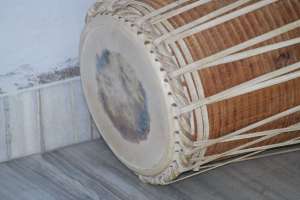
Pakhawaj–Indian Drum (पखावज)
Pakhwaj (पखावज) is called the mother of North Indian style drums—the world famous drum called Tabla came from this instrument. Legend goes that famous musician Amir Khusro was playing Pakhawaj and it broke in two pieces—when he tried to play the pieces, it worked and from here came the new instrument called Tabla.
[youtube=http://www.youtube.com/watch?v=klgWDQD9nJA&w=320&h=265]
Pakhawaj is very good drum in the shape of barrels and often is categorized with Mridungam, which is almost similar to Pakhawaj and its South Indian counterpart. Pakhawaj has its origin in ancient times and it is believed that Lord Ganesha uses this instrument. In one of the most difficult type of North Indian classical music called as Dhrupad, Pakhawaj is a standard accompaniment drum. The voice of Pakhawaj is very dense and is very appealing to ears. When I heard Pakhawaj for the first time, I almost totally forgot any other drum instrument. However, at the same time, other drums have evolved themselves much and there are lots of articulations that these drums can make and therefore have their own place.

The smaller or treble head of Pakhawaj is just like the smalled head of the Tabla. However, on the bigger head, there is no black part on outer side—this is inside in case of Pakhawaj: it means you won’t be seeing it on the bigger head. Though Tabla has come up from Pakhawaj itself, it has excelled far into varieties and with continuous improvements and experimentations in its style and form it has emerged as an independent instrument. Pakhawaj has very little use now-a-days. Only hardcore classical music uses Pakhawaj.

The playing style of Pakhawaj is almost similar to any Indian drum with one difference; and this one difference is major one: audience, who is used to Tabla or Mridungam or any drum for that matter, would find it very difficult and different while listening to Pakhawaj. Tabla and Mridungam have “Thekas”, which means a continuous beat of certain notes. This is played throughout any composition with additional and supplementing articulations on the part of drummers. However, in case of Pakhawaj, there are not “Thekas” and very often you will find the Pakhawaj silent. This is where audience sometimes finds it difficult. However, once the Pakhawaj comes into speed, it becomes almost matchless—you will feel bowled over by the density of its notes.

In ancient Indian devotional singing, Pakhawaj was an integral part and it still remains one of the most famous instruments whenever some composition is made on ancient spirituality of India. No doubt that the Pakhawaj sprouts a passion in you and you would like to have it for your own—this is what happened with me and eventually I bought one for me. Though I do not how to produce that kind of melodious music from it, but I satisfied myself by playing on it freely—and it was very exhilarating experience for me indeed. Hope you would also love this old and ancient instrument when you hear its melodious and enchanting sound!


